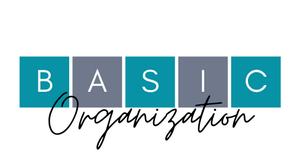“Kiss Your Clutter Goodbye”- Part 7
The Kiss Your Clutter Goodbye Series
Welcome to Part 7 of the “Kiss Your Clutter Goodbye” series. This is the last of the series, where we are exploring some organizing concepts that will help you declutter and maintain your newly organized spaces.
This concept may seem like a no-brainer to you, but to some folks, it’s very helpful to learn or to be reminded that simple concepts are best. There’s no reason to make decluttering and organizing harder than it has to be.
Put Like-Items Together
For a true visual of what you own, gather like items. After you’re finished grouping, you can contain each collection. Assign dresser drawers to hold a certain type of item and label each pantry shelf as to what should be stored there. Once you have grouped like items, consider the stuff that is left. This is the hardest part. Those odd pieces will challenge you. Don’t give up! Here are some tips to help you out:
- Don’t limit yourself to one room of the house. Gather items like office supplies from everywhere.
- If you find two of the same thing, keep the newest, best one and consider letting go of the other.
- Start with one small space, like a drawer or shelf, Clear the space then only replace the items that you use.
It works because once you have gathered all like-items you’ll know what you have, or should I say what you have too much of. With homes for like-items, you won’t struggle to find items and won’t buy things to replace items you can’t find.
Put Like-Items Together Share on X
I hope you have enjoyed the “Kiss Your Clutter Goodbye” series and that you found one or two decluttering and organizing strategies that worked for you. If you’d like to revisit the other posts in the series you can use the links below.
Subscribe by email
Enter your email address to subscribe to this blog and receive notifications of new posts by email.
Janet Schiesl

Janet has been organizing since 2005. She is a Certified Professional Organizer and the owner of Basic Organization.
She loves using her background as a space planner to challenge her clients to look at their space differently. She leads the team in large projects and works one-on-one with clients to help the process move quickly and comfortably. Call her crazy, but she loves to work with paper, to purge what is not needed and to create filing systems that work for each individual client.
Janet is a Past Board Member of the National Association of Productivity and Organizing Professionals and a Past President of the Washington DC Chapter of NAPO were she has been named Organizer of the Year and Volunteer of the Year.

Janet Schiesl
Janet has been organizing since 2005. She is a Certified Professional Organizer and the owner of Basic Organization.
She loves using her background as a space planner to challenge her clients to look at their space differently. She leads the team in large projects and works one-on-one with clients to help the process move quickly and comfortably. Call her crazy, but she loves to work with paper, to purge what is not needed and to create filing systems that work for each individual client.
Janet is a Past Board Member of the National Association of Productivity and Organizing Professionals and a Past President of the Washington DC Chapter of NAPO were she has been named Organizer of the Year and Volunteer of the Year.

It can be very difficult for some people to discern which things belong together because their instinct is to create categories that are too narrow. Grouping like items is a truly valuable exercise. I think doing this also helps people to see that they have more of a certain category than they thought and may lead them to set better boundaries.
How many times have we heard clients say “Oh I didn’t know I had so many, or I had that” things get shoved into drawers and cabinets and get forgotten. It is a great way to pull everything out and sort.
I love the group-like-with-like organizing principle. It helps with evaluating, organizing, and preventing overbuying.
I agree, if you can see it then it’s easier to find a home for it, whether inside the house or.
I’m definitely a believer in like with like. It is step one when emptying any space we are organizing.
Sometimes I have repeats of items on different floors. For instance, I have one pair of scissors in the kitchen, and another upstairs in my laundry room. I don’t like having to run up and downstairs for scissors.
In most spaces, I try and group like items together. I have half of my sock drawer for white socks, and the other half for non-white socks. In my husband’s case, I have separate drawers for the different colored socks, and they are labeled, because he can’t see the colors. Even I have trouble discerning black from blue in men’s socks. I think they should write this out on the toe of the socks. Anyone with me?
That’s funny you mention that about the socks. In some cases they look the same.
Every once in a while I go around and collect all the pens and pencils, that somehow found their way into my drawers, and I give them to the buy nothing group, someone else could use them.
Add me to the list of “like with like” followers.
Diane (above) is correct, of course, that some people make categories that are too narrow; another issue for some of my neurodiverse clients is that they’ll come up with similarities based on features I wouldn’t have considered. Like, they’ll identify categories like “blue things” and “red things,” or “things I bought for myself” vs. “things someone else bought” — all accurate, but not useful. By focusing on “like with like” and noting that the likeness relates to function (how, when, where, and why something is used), the logic shines. One of our colleagues on TikTok talks about grouping family/cousins (similar items) and co-workers (different items that perform similar functions, like tape, glue, and staples), and I find that charming. And I particularly like your point about keeping and using the best and letting go of the rest. You must be so happy with all you accomplished in this series.
Yes I agree with you on the accuracy but not useful, it’s more complicated and then there is no space for all of that.
Thanks, I’m glad you enjoyed my series Julie.
I use the group-like with like items together also. I found that people are unsure what characteristic to base the like grouping on. For instance is a group based on location these are things I use in the kitchen, how much I like it, it was a gift etc. I find I need to make sure the client knows it is based on function. It seems simple but not all brains think alike, With that in mind the groups need to match how the client thinks not how I think.
For sure, for example a tool box can be organized by categories, different nail, screws, screwdrivers etc. keep what you think you need and get rid of the rest, unless you are a woodworker. The point is to make it simple, visual and easy access to it.
Thanks Julie.